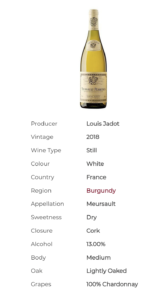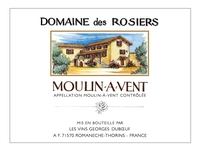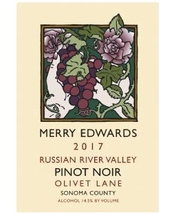Category Archives: Uncategorized
Christophe Ferrari Domaine St. Germain, Plein Sud, Irancy. Burgundy, 2019
Domaine Louis Jadot, Meursault, 1er Cru Perrieres, Burgundy, 2018
 Drinking Window: 2024 – 2034
Drinking Window: 2024 – 2034Georges DuBoeuf, Moulin-à-Vent (Beaujolais, France) “Domaine des Rosiers” 2019
($27, Quintessential Wines):  Wines from Moulin-à-Vent tend to be the sturdiest of all Beaujolais crus because of the granitic soil in that area. And there’s no doubt that you can taste and feel its presence in this wine. This Moulin-à-Vent, the most mineral-y of this trio of DuBoeuf Beaujolais crus, finishes with a balancing and welcome hint of bitterness. … Read more
Wines from Moulin-à-Vent tend to be the sturdiest of all Beaujolais crus because of the granitic soil in that area. And there’s no doubt that you can taste and feel its presence in this wine. This Moulin-à-Vent, the most mineral-y of this trio of DuBoeuf Beaujolais crus, finishes with a balancing and welcome hint of bitterness. … Read more
Merry Edwards, Russian River Valley (Sonoma County, California) Pinot Noir Olivet Lane Vineyard 2017
($68):  First planted in 1973 by the Pellegrini family, the Olivet Lane Vineyard was one of the first in the Russian River Valley devoted to Pinot Noir and Chardonnay. Merry Edwards has used Pinot Noir from Olivet Lane for a single-vineyard bottling since the founding of her winery in 1997. … Read more
First planted in 1973 by the Pellegrini family, the Olivet Lane Vineyard was one of the first in the Russian River Valley devoted to Pinot Noir and Chardonnay. Merry Edwards has used Pinot Noir from Olivet Lane for a single-vineyard bottling since the founding of her winery in 1997. … Read more
Pacific Rim Winery, Yakima Valley (Washington) Riesling Solstice Vineyard 2014
($23): Pacific Rim Winery, based in Washington’s Columbia Valley, specializes in Riesling and other aromatic white varietals. This one, from a small (2.5-acre) vineyard with 40+ year-old vines, is stunning. Crisp and clean, it has a delicacy and laciness that belies its depth of flavor. … Read more
Domaine Fournier, Sancerre (Loire Valley, France) “Cuvée Silex” 2008
($38, David Milligan Selection): I know, why pay $38 for Sancerre when so many good ones go for less than $30? Simple, this one’s unique and worth every penny of it. Fournier is one of Sancerre’s star producers. His Cuvée Silex comes from a distinctive 5-acre parcel whose soil is mostly flint.… Read more
How to cancel your Apple Music subscription on Mac
Apple Music was starting late taken off to a couple of countries over the world, with a 3-month free trial. Additionally, being a music spilling organization from Apple, various customers have been willing to give it a shot. Nevertheless, if you have to suspend your scratch off Cancel Apple Music Subscription enrollment for no good reason, you need to physically stop from the organization with a particular ultimate objective to balance getting approached the complete of the ideal opportunity for testing.… Read more
Erath, Oregon (United States) Pinot Noir 2006
($19): Dick Erath was a pioneer in the Oregon wine industry when he planted his first vines about 40 years ago. Erath is still a leader in producing top-notch wines, especially Pinot Noir. This straightforward wine, made from purchased fruit from throughout the state, has simple, direct, cherry-like fruit flavors touched by a hint of earthiness. … Read more
